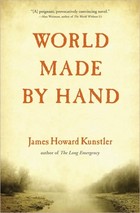“World Made by Hand” by James Howard Kunstler

My friend M from Mental Multivitamin recommended James Howard Kunstler’s novel, World Made by Hand, years ago. I saw him speak at a book festival after the sequel was published. He was an engaging, if irascible, speaker who had no qualms about criticizing Minneapolis streets and its downtown. Coming from any other artist, this might be construed as an insult. Yet JHK (whose last name is unwieldy to pronounce and whose mispronunciation might be misconstrued by my kids) is a writer of both fiction and non-, with a focus on suburban sprawl and energy (mis)use. So while his critique might not be polite, it was, perhaps, true, and I wish I could recall whether he discussed exactly what annoyed him about downtown Minneapolis other than the one-way streets, and Nicollet Avenue which is, like one of the big tree streets in Philly–Walnut? Chestnut?–closed to car traffic but open to bikes buses and emergency vehicles.
In World Made by Hand, JHK merges his two areas of non-fiction interest into a fictional tale of a future upstate New York. The oil has run out, bombs have been dropped, illnesses have devastated the population, and those who remain now live in post-industrial communities of various sorts: agricultural communities, religious enclaves, lord and serf, ruler and subject.
The narrator is Robert Earl, a former computer man of a certain age, who is a woodworker, fiddler, widower and all-around decent, hyper-competent guy. Soon after he and his friend Loren, the town’s preacher, encounter a religious group about to settle in the town, an act of violence occurs that shakes the town and Robert out of complacency, putting many gears in motion that play out interestingly over the course of the novel. One question that plays through till the end are whether the religious group is benevolent, malevolent, or perhaps both. This intertwines with the other question of whether the initial act of violence will be ignored, or taken up in a return to justice.
The tensions and drama pulled me through the novel briskly. I very much enjoyed pondering JHK’s vision of a post-oil society, and recognizing some truths that would have been obvious had I ever had occasion to give them thought before: something as simple as no black pepper, or how bicycles would not be useful because parts would be irreplaceable after time, but more critical would be the roads disintegrating.
We didn’t have coffee anymore, or any caffeinated substitutes for it. I made a pot of rose-hip tea, which was our chief source of vitamin C, and fried up three slices of Jane Ann’s brown bread with plenty of butter in a cast-iron skillet that I had owned by entire adult life–I actually remembered buying it in a Target store… (25)
Alas, sometimes the description became more preachy, when the narrator related opinions on oil consumption, suburban housing, and more. A handful of times, I could feel JHK’s soapbox underneath the narrator’s feet, and I wished for a better integration of lesson and story.
A few other things kept me from full-on loving this story. There is a dearth of female characters, but those there are don’t interact (i.e., fails the Bechdel test) and three of the four most prominent sleep or want to sleep with the narrator. This reminded me of Stiegg Larsson’s Mikael Blomkvist–a dashing journalist and detective who was irresistible to women. I would have appreciated it if Robert had been less idealized, and like JHK, and surrounded by better developed characters. There were plenty of potentially interesting characters, but we learned so little about them in this book that I can only hope that fleshing them out is part of the sequel, The Witch of Hebron.
As the book winds up, there are elements of horror, magic, and the grotesque brought in that reminded me of Stephen King. These were interesting, but perhaps contrary to what I felt worked best–the complex communities and lifestyle changes that develop in the wake of a post-oil USA. Again, perhaps the surreal elements get fuller treatment in the sequel, but I felt these elements both added and took away from this story.
With these concerns, though, I still recommend the book. It has me thinking on energy use, and curious to read books such as Alan Weisman’s The World Without Us (Weisman is a blurber for this book) and Maggie Koerth Baker’s Before the Lights Go Out. I plan to read the sequel, The Witch of Hebron. And in the meantime, I’ll be thinking about what kind of skills it might be useful for me to brush up on in case the lights go out in our lifetime. Because blogging sure wouldn’t be one of them.